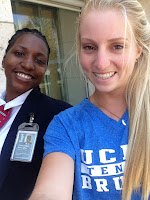Event Three: Hammer Museum
I went to the Hammer Museum as my third event. I got to see
many interesting exhibits and a great time and loved comparing this art to the
previous museums.
The first exhibit I went in to was Mary Reid Kelly’s
black-and-white video exploring the myth of the Minotaur. It was absolutely
nothing like what I expected. I thought it would be a historic documentary with
mythological Greek theories. The hybrid was half woman instead of half man. It
was interesting that the visual language aligns with the artists’ own writings.
Although it may not seem like it, her video explores the roles of women,
sexuality, and language.
One of the most interesting pieces of art that I saw was
James Deller’s “The History of the World.” This really stood out to me because
EDM is one of my favorite genres of music, so I was immediately drawn to it
when I saw “acid house” and “brass bands.” This image portrays the history,
influence, and context for these two types of music. Not only is this textual
portrayal about the music, but also suggests much broader social and political
points that date from different eras. It also looks like this image is just a
random flow chart, but it is actually a diagram that has been carefully organized.
When I first saw this piece of art by Mark Hagen, I thought
looked really cool and simple. The triangles reminded me of the geometry class
I took in high school. I wanted to know more about the artwork so I read the
excerpt on the artist Mark Hagen. I learned that he uses contradictory
materials and often engages in DIY building. He is not a traditional artist in
the sense that he uses unusual materials such as cement, steel, burlap, house
paint, and obsidian to create art that embraces modularity, seriality, and
geometric repetition. As shown in this piece of art, his style aims to create
works that are disorganized as they are organized. According to the excerpt on
the wall, he has cast cement units from imported plastic beverage containers,
cardboard packaging, and a mold made from the 1960’s ceramic tiles on the
façade of the abandoned Rampart police station near downtown LA. This just goes
to show that art can be found virtually anywhere.
I had a really great experience at the Hammer Museum and
exploring all of the current collections. I thought that a lot of the exhibits
were different from that of other museums. I learned a lot from this event and
would highly recommend going to this museum.
 |
| The worker wasn't allowed to take a picture with me, so this is my ticket :) |


















